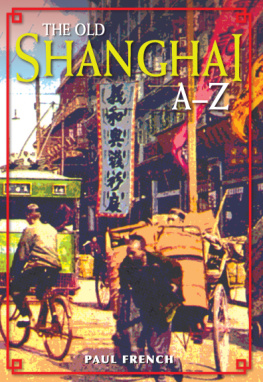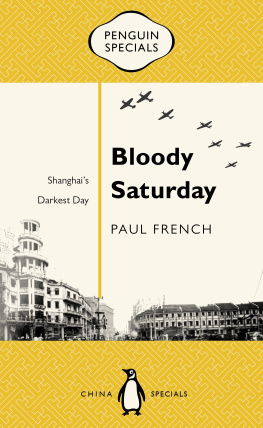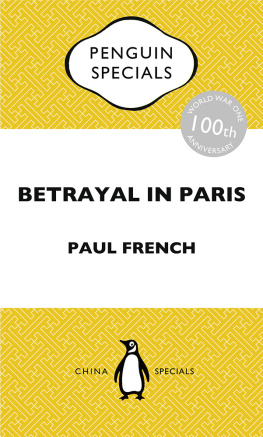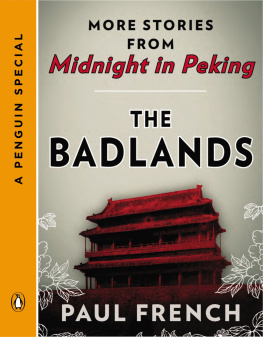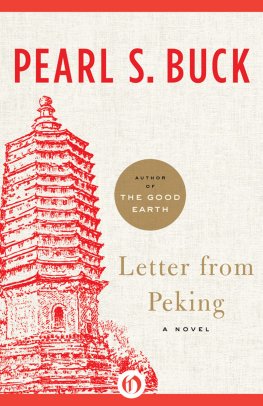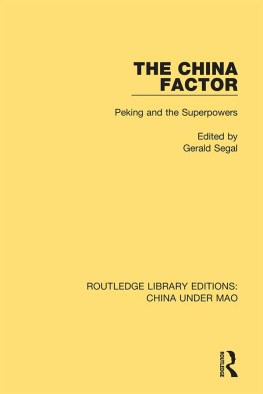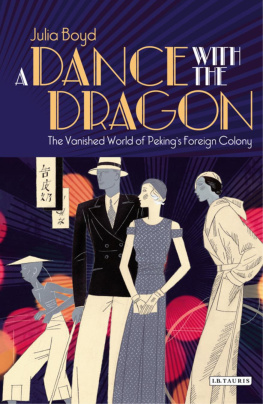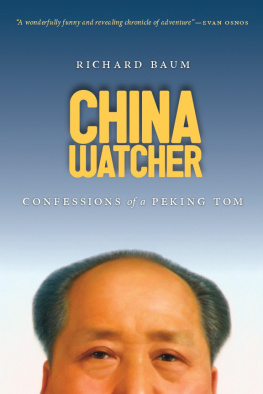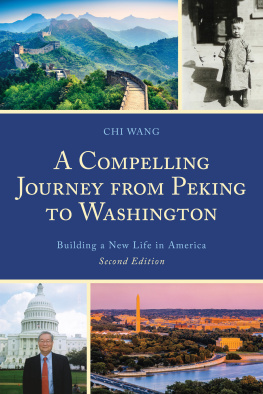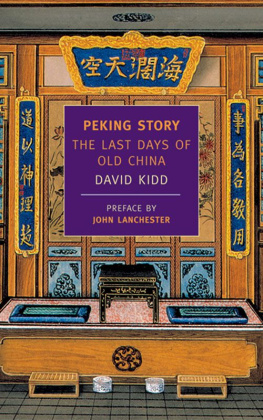Thanks to all those people Ive talked old Peking with over the years: Paul Bevan, Robert Bickers, Julia Boyd, Douglas Clark, Patrizia van Daalen, Ambassador Extraordinary and Plenipotentiary of the Russian Federation to the Peoples Republic of China Andrey Denisov, Peter Goff, Fred Greguras, Simon Rom Gjeroe, Anya Goncharova, Jiang Wen, Jeremiah Jenne, Sarah Keenlyside, Ned Kelly, Katya Knyazeva, Ed Lanfranco, Melinda Liu, Jeffrey Long, Thomas OMalley, Michael Meyer, Lars Ulrich Thum, Ying Wei and Frances Wood.
Wallis Simpsons time in China has long interested me mostly because of what everyone thinks they know about Wallis, her life, and her adventures in China ninety-nine per cent of which is completely and utterly wrong. I still have plans to set that particular record straight sometime soon. Walliss biographer Anne Sebba was a wealth of information on all aspects of the Duchess of Windsors life and was kind enough to share her in-depth research and thoughts with me. My thanks to Sarah Keenlyside of Bespoke Beijing as well as the management and staff of the Nuo Hotel Beijing, which now occupies the original Grand Htel de Pkin that Wallis knew, for facilitating several stays at the old Grand Htel. The original part of what is now the Beijing Hotel complex that Wallis would have known is now the Nuo (a.k.a. the charmingly named Block B). The Stalinist-inspired part of the hotel to the west (Block C) was added in 1954; the hotel on the corner of Wangfujing that resembles a public housing project (Block D) was added in 1974. The creation of this uninspiring piece of architecture necessitated the sad demolition of the original red-brick 1915 wing. Who the hell knows what happened to the non-existent Block A? Block B has been added too at the rear with a sort of shopping mall-cum-hotel and false ceilings throughout. The famous rooftop is now permanently closed and forgotten. But there are some nice touches some interior windows and the main staircase (though spoiled at higher levels by false ceilings) remain, which make it worth a visit.
An anonymous bookseller at the excellent Elliott Bay Book Company in Seattle first found me a copy of Curzio Malapartes The Kremlin Ball. Despite Malapartes often unpleasant politics and associations on both the left and the right I had long been a fan of his two war reportage books, Kaput and Skin. When Malaparte mentioned Karakhan he excited my interest.
Peking Takedown developed out of research and writing done for a commissioned narrative-drama for BBC Radio 3, Peking Noir. My thanks to Sarah Wooley who wrote the dramatic scenes for that production and to Sasha Yevtushenko for pushing so hard to get that show made and then producing it. Professor Robert Bickers of Bristol University was kind enough to share his knowledge of Peter Lawless with me while Chinamarine.org were kind enough to allow me use of their photographs of Dewolfe Schatzel.
Two great Shanghai historians, Tess Johnston and Patrick Cranley, helped me track down Denton Welchs teenage home at the Rivers Court Apartments. Thanks to Shanghailander photographer Graham Keelaghan for photographing the remaining buildings for me so assiduously. Rachel Rapaport and Julie Chun at the Royal Asiatic Society in Shanghai kindly invited me to talk about Denton Welch in 2019, which gave me an excuse to look at his time in Shanghai and Peking in greater detail.
Peking is Like Paris was originally published in the Journal of the Royal Asiatic Society (China) as Peking is Like Paris Isamu Noguchi and his Encounter with Pekings Avant-Garde Milieu in 1930, Vol.76, No.1, 2016. That article was itself an extended version of a lecture I gave entitled Peking 1930 at The Noguchi Museum, Long Island City, New York in October 2013 to coincide with the museums 2013/2014 exhibition, Isamu Noguchi and Qi Baishi: Beijing 1930. I must thank the editor of that edition of the RAS China Journal, Lindsay Shen, and Dakin Hart, Senior Curator at the Noguchi Museum. Since writing the original article I have discovered some more details on the amazing life of Nadine Hwang, some of which have been added to this chapter. For some of those details my thanks go to the Archivo China Espaa.
Edmund Backhouses best biographer Derek Sandhaus was kind enough to talk through his last days with me, and to share his copy of Hoepplis postscript to Dcadence Mandchoue. Jeremiah Jenne helped me locate Backhouses former Peking addresses. My thanks also to Jean-Louis Bussiere for information on his father.
I found the time to research more on Eugen and Helma Otts time in Peking after being commissioned to review Owen Matthewss biography of Richard Sorge for the South China Morning Post in Hong Kong. My thanks to Adam Wright for commissioning that review, and to Adam Cathcart of Leeds University for pointing me in the direction of more information on Dr Walter Fuchs.
I have long loved Harold Actons Peonies and Ponies. Frances Wood, the Sinologue, author and former curator of Chinese collections at the British Library until 2013, shared with me her ideas about who Acton based his characters on; as did Julia Boyd, the author of A Dance with the Dragon: The Vanished World of Pekings Foreign Colony. I also very much enjoyed talking about the Peking aesthetes with the historian Jeremiah Jenne at the now gone and sorely missed Beijing Bookworm, and then again courtesy of Sarah Keenlyside and Sam Braybon at Bespoke Beijing. Jeremiahs article for the Los Angeles Review of Books China Channel entitled The Peking Aesthetes is a good summation of our conversations on Acton, Parsons, Kates, Blofeld et al. My thanks to Jeffrey Long of Long Bros. books in Seattle and to Peggy Hartzell for additional details on Thomas Handforth.
Olga Fischer-Togo proved extremely elusive. However, I am extremely grateful to Mtys Mervay who offered me his own research on Olga during World War One that answered a number of queries about her true nationality (or nationalities). His paper, A Research on the Austro-Hungarian Prisoners of War in China During World War One, Masters (M.A.) Thesis (in Chinese), Nankai University, 2017, was also useful.
Dr Anne Witchard of the University of Westminster first introduced me to Ellen Newbold La Motte. Then the independent publisher Camphor Press in Taiwan republished the rather hard-to-get Peking Dust as an e-book. That meant that I was able to include comments by La Motte in my Penguin China Special, Betrayal in Paris: How the Treaty of Versailles Led to Chinas Long Revolution (2016), that was part of Penguin Chinas collection of short books related to Chinas involvement in World War One. The wonderful Heywood Hill bookshop in Mayfair tracked down the Evelyn Waugh essays for me.
Megan Walsh Gerard kindly found time to visit the Georgia Historical Society Archives in Savannah to search for forgotten Harry Hervey movie treatments when I was too far away and couldnt come up with a good excuse to go to Georgia. Also, Herveys principal biographer Harlan Greene, author of The Dead Dont Cry They Just Disappear: The Life and Works of Harry Hervey, kindly encouraged me to make further explorations into Harrys Asian sojourns. My wider interest in von Sternbergs movies stems from childhood TV watching. However, I must thank Tammy Lai-Ming Ho, a founding co-editor at Hong Kongs Cha: An Asian Literary Journal, who encouraged me to write about von Sternberg. My article, Mayhem in Macao: Josef von Sternbergs Fantastical Macao of the Mind, is available in the Macao Special Issue of Cha online (Issue 43, April 2019).
My essay on Martha Sawyers and her husband Bill Reusswig first appeared in a slightly different form in the South China Morning Post weekend magazine. My thanks to Dave Besseling for commissioning and editing, and Antony Dickson for sourcing images.


